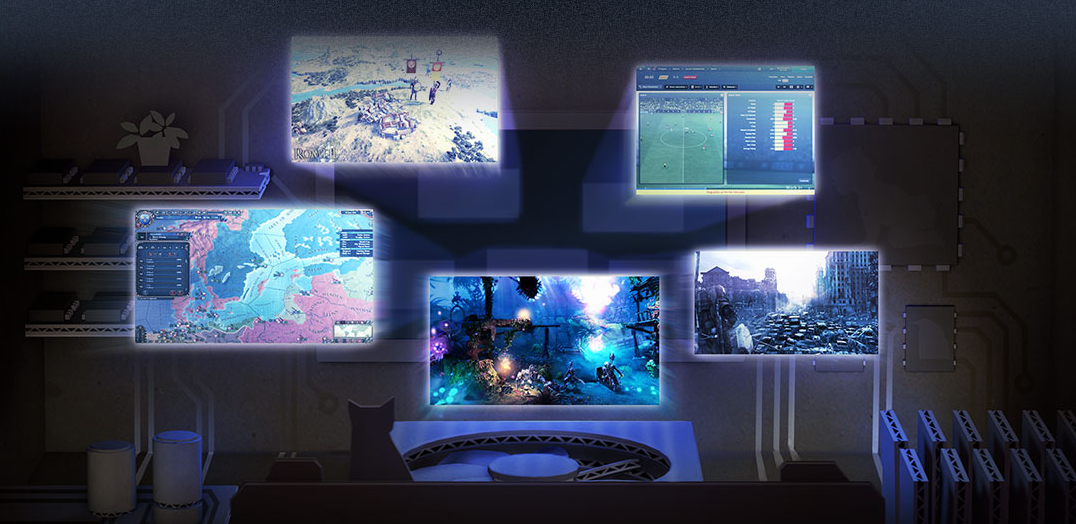SteamOS Brings PC Games to Your Living Room

There are two typical classifications of video games: those played on your computer and those played on your console. The former belong, logically enough, on your Mac or PC and are therefore usually played in an office, den, or at computer desk pushed up against the wall. The latter gets the honor and the perks of being played in the living room: a bigger display, a comfy couch capable of seating more than one players at a time, and a more social gaming experience. Now the cloud-based gaming platform Steam has released a new operating system aimed at helping computer games move off the sequestered small screen and onto your living room television.
SteamOS Beta Offers a “Multiple Choice Answer” to Gaming
Earlier this winter, Steam released the beta of the operating system it will use to bring its expansive PC gaming library into a more console-style gaming environment, SteamOS. Steam, which is well-known for offering a collection of big production and indie games for download to Windows, Mac, and Linux PCs, has worked hard on building this new operating system to be used in their Steam Machines, console-like computers that are designed to let gamers run Steam and play their favorite computer games from the comfort of their couch. The idea of closing the environment gap between computer games and console games is not a new one for Steam, who has been considering how best to translate the Steam Play experience into a console-like one for a long time. In the end, it was decided that what it would take to maintain the familiarity and ease of using Steam to download and play your favorite computer games was the development of an entirely new OS, specifically tailor made for running Steam.
“As we've been working on bringing Steam to the living room, we've come to the conclusion that the environment best suited to delivering value to customers is an operating system built around Steam itself,” the Steam team explains on the SteamOS homepage. “Finally, you don’t have to give up your favorite games, your online friends, and all the Steam features you love just to play on the big screen.”
To do this, SteamOS has been built on a core of Linux Debian Wheezy, also known as Debian 7. “SteamOS combines the rock-solid architecture of Linux with a gaming experience built for the big screen,” the homepage announces. However, the Steam Machines will be able to run Mac and Windows games just fine as well– a streaming capability allows you to run Steam on your regular computer, while playing it on your TV over your local network. “Just turn on your existing computer and run Steam as you always have – then your SteamOS machine can stream those games over your home network straight to your TV!” SteamOS will also be able to run apps that allow it to be used as a media device, playing your movies, television shows, and music as well as your favorite computer games.
Of course, some of Steam's biggest amenities have always been its customizable gaming experience, its encouragement of new games via Steam Greenlight, new technologies, new apps, and new opportunities. SteamOS is prepared to let you customize the way you game on a Steam Machine too– being billed as less of an operating system and more of a “co-operating system.”
Steam is not a one-way content broadcast channel, it’s a collaborative many-to-many entertainment platform, in which each participant is a multiplier of the experience for everyone else. With SteamOS, “openness” means that the hardware industry can iterate in the living room at a much faster pace than they've been able to. Content creators can connect directly to their customers. Users can alter or replace any part of the software or hardware they want. Gamers are empowered to join in the creation of the games they love. SteamOS will continue to evolve, but will remain an environment designed to foster these kinds of innovation.
It gains its co-operative and customizable status in a number of ways– starting with the Steam Workshop, which works just like it would normally. Steam Workshop will allow players to download, create, modify, and publish new user-created content for the games that they can now play on the big screen. They also aren't kidding about letting you alter or replace the software or hardware– the software is open-source and the hardware for the Steam Machines isn't so much ‘hardware' as ‘a list of minimum system requirements.' This means that you're free to purchase a Steam Machine from Valve, Alienware, or another manufacturer, or you can build your own, or, if your current rig is up to par and you want to convert it to a Steam Machine, you'll be able to download SteamOS straight onto your machine. (Keep in mind, this will wipe everything on it.)
Though Steam Machines and SteamOS are currently only available to those who are taking place in the beta testing, an alpha version of the OS, as well as the sale of multiple Steam Machines made by various manufactures, should be available later this year.
Are you excited to move your computer games into the living room? How much of a competitor do you think the Steam Machine will be for other consoles? We'd love to hear your thoughts in the comments!


